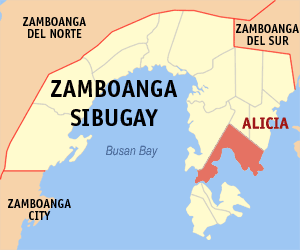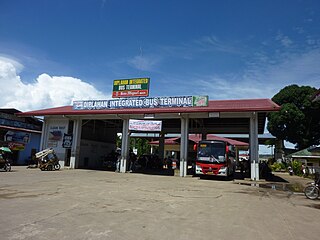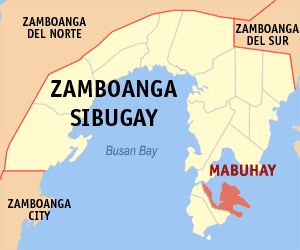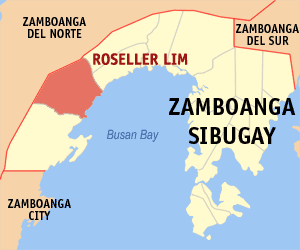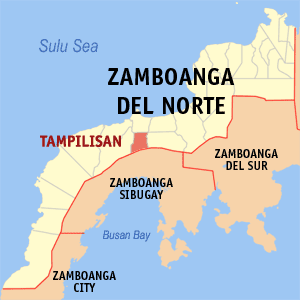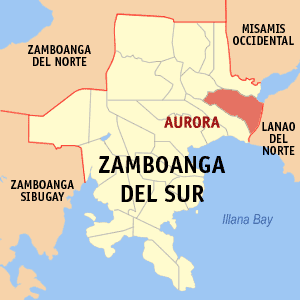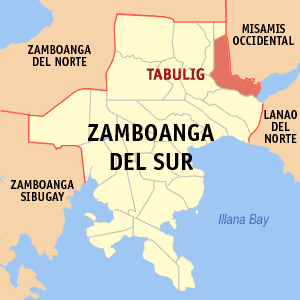Tungawan | |
|---|---|
| Municipality of Tungawan | |
 Map of Zamboanga Sibugay with Tungawan highlighted | |
Location within the Philippines | |
| Coordinates: 7°30′N122°22′E / 7.5°N 122.37°E Coordinates: 7°30′N122°22′E / 7.5°N 122.37°E | |
| Country | |
| Region | Zamboanga Peninsula (Region IX) |
| Province | Zamboanga Sibugay |
| District | 2nd District |
| Founded | May 24, 1960 |
| Barangays | 25 (see Barangays) |
| Government | |
| • Type | Sangguniang Bayan |
| • Mayor | Carlnan C. Climaco |
| • Vice Mayor | Ivan N. Balano |
| • Congressman | Dulce Ann K. Hofer |
| • Electorate | 22,981 voters (2016) |
| Area | |
| • Total | 473.28 km2 (182.73 sq mi) |
| Population (2015 census) [3] | |
| • Total | 42,030 |
| • Density | 89/km2 (230/sq mi) |
| Time zone | UTC+8 (PST) |
| ZIP code | 7018 |
| PSGC | |
| IDD : area code | +63 (0)62 |
| Climate type | Tropical climate |
| Income class | 2nd municipal income class |
| Revenue (₱) | 144.1 million (2016) |
| Native languages | Subanon language Cebuano Chavacano Tagalog |
| Website | www |
Tungawan, officially the Municipality of Tungawan, is a 2nd class municipality in the province of Zamboanga Sibugay, Philippines. According to the 2015 census, it has a population of 42,030 people. [3]

Zamboanga Sibugay is a province in the Philippines located in the Zamboanga Peninsula region in Mindanao. Its capital is Ipil and it borders Zamboanga del Norte to the north, Zamboanga del Sur to the east and Zamboanga City to the southwest. To the south lies Sibuguey Bay in the Moro Gulf.

The Philippines, officially the Republic of the Philippines, is an archipelagic country in Southeast Asia. Situated in the western Pacific Ocean, it consists of about 7,641 islands that are categorized broadly under three main geographical divisions from north to south: Luzon, Visayas and Mindanao. The capital city of the Philippines is Manila and the most populous city is Quezon City, both part of Metro Manila. Bounded by the South China Sea on the west, the Philippine Sea on the east and the Celebes Sea on the southwest, the Philippines shares maritime borders with Taiwan to the north, Japan to the northeast, Vietnam to the west, Palau to the east, and Malaysia and Indonesia to the south.
Contents
It has an area of 47,328 hectares (116,950 acres) of land, the largest in the province, as well as 15,236 hectares (37,650 acres) of coastal waters.
It was declared as a Municipality on May 24, 1959, and started functioning as an LGU on January 29, 1961, by virtue of Executive Order No. 395. [4] Its name was coined from the minute leech generally known as “tungaw” of the Hirudo family.
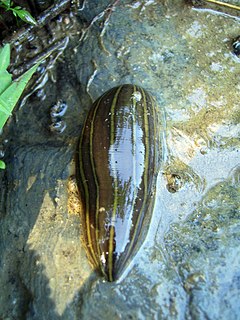
Hirudo is a genus of leeches of the family Hirudinidae. It was described by Linnaeus in 1758.
Tungawan's economy is primarily based on agriculture, producing rubber, coconut, corn, rice, and seaweeds. It is home to the 880 hectares Bangaan Marine Sanctuary at Barangays Linguisan and Tigbucay.


